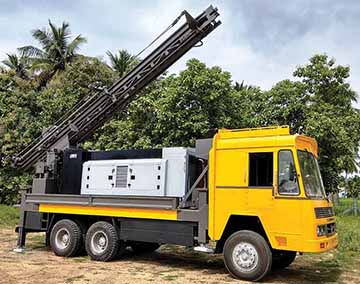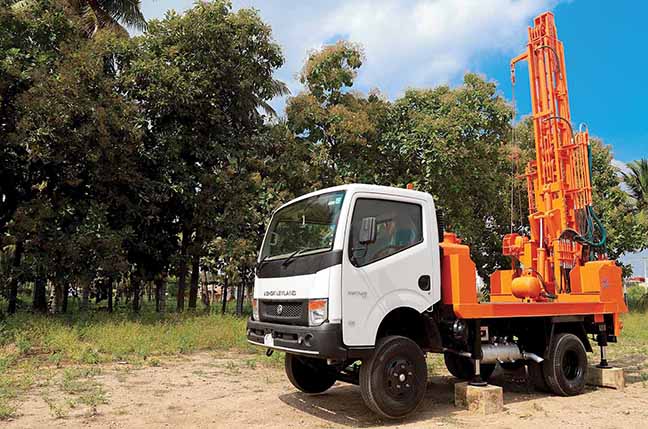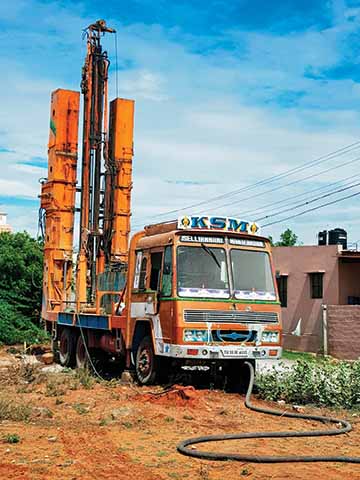Story by: Bhushan Mhapralkar
As the debate on bore wells rages in the wake of the depleting water table in many parts of India, a sizeable section of the population in the country makes a living out of drilling them. Most of them are to be found in a town called Tiruchengode, Tamil Nadu. Often linked to an activity that involves hydro-geologists that come swinging a pendulum in response to a call by local as well as regional politicians looking at addressing the need of their constituencies to have water in the wake of an exploding population by drilling as many bore wells as they can, often to provide supplemental water, drill rigs are had in various types, shapes and sizes. Tracing their root to the 1970s when many regions in India started to lap up the new-found demand for drill rigs in response to the scarcity of water and the resulting destruction of crops, the drill rigs of Tiruchengode amount to an estimated 8000 to 10000 in numbers. Entering into the business by pooling money after seeing their crops getting destroyed by the famine in the early and mid-70s, the farmers of Tiruchengode bought a few rigs.

Their prime objective was to drill deep down to seek water for agriculture. A part of the drill rig industry for the last 35 years, and form a president of Tiruchengode Rig Owners Association (TROA), M. Subburathinam mentioned that bore wells were initially drilled solely for agricultural needs. They were mainly used to satisfy the agricultural demand. “It is only in the recent years that the demand for domestic and commercial purposes has increased,” he added. Of the opinion that close to 75 per cent of the bore wells are drilled for agriculture even today, Subburathinam averred that the rigs from Tiruchengode move all over the country to drill bore wells. It is a tough job, expressed a drill rig operator. A big hurdle often faced by the company that operates the drill rig is to reach the location. Since the drill rig is installed on a 6×4 truck bed, it is often difficult to manoeuvre it to the designated spot of drilling, he stated. Once at the spot, to ensure the verticality of the bore is a big challenge, he added. With a drill rig costing in the region of Rupees one-crore to Rs.1.5 crore, the business of operating it hinges on the premise of achieving ROI through as many jobs in a year as possible. With an estimated 500 to 1000 drill rigs added to the fraternity every year, it often gets quite competitive, according to a drill rig operator from Triuchengode. What makes it feasible however is the demand for drill rigs, he informed.

Built by procuring (often 25-tonnes GVW) truck chassis from CV manufacturers – the preference is for Ashok Leyland trucks (Taurus 2516, 2523, etc.), the drill rigs have a life of seven to ten years, according to Subburathinam. Stating that drilling is not for the weak at heart, Mohammed Rafi, the owner of Rafi Rig Service at Tiruchengode said that one has to dig deep into the reserves; dig deep into the spirit of resilience, and know the tools, techniques, processes, and applications well. He averred that the preference is for trucks chassis with higher horsepower. Revealing that Ashok Leyland is the most preferred choice, and supplies a chassis that suits the purpose, Rafi said that the horsepower rating is typically 280 hp. The equipment on the rig is often powered by a power take-off from the truck engine. Specialising in fabrication, modification, reconditioning, overhauling and re-manufacture of hydraulic components in pumps, motors, valves and cylinders, Rafi informed that the rigs are found in different types such as the box type, semi-sensor type, and the sensor type. The sensor type rig, he added, costs close to Rupees-one and a half crores. Also classified as per the variety of drill, including rotary cum DTH rig, truck mounted DTH rig, skid mounted horizontal drill rig, etc., the considerable cost of a drill rig speaks about the need to strive for a return on investment. The drill rigs of Tiruchengode thus travel far and wide. They travel to places in Karnataka, Maharashtra, Madhya Pradesh, Orissa, and Rajasthan very often.
The average number of borewells drilled by a truck varies from 200 to 500 in a year. This could be attributed to the deteriorating water levels – often from 600 to 1,300 feet. Performing a ‘pooja’ to propitiate the gods of water and earth in true Indian style before undertaking the task of drilling a bore well, the first 100 feet or so are usually easy to uncover. With dust flying all over the place it isn’t the cleanest of tasks by a good margin. The going can get tough as hard rock is encountered as the drill digs deeper in the earth strata. Progress can be slower than expected and involve the change of drill bits and other equipment. It is not unusual for progress to slow down to one-feet a minute or even less. It is not unusual for the compressor to drink diesel at a rate of one-litre per minute or more as it feeds energy to the drill. The process often conducted from early in the day to well into the night, and for days together at times, the drill rigs of Tiruchengode reflect professionalism of a rare kind. Said Subburathinam, that the increasing demand for drill rigs is intrinsically linked to the explosion of population in most parts of the country. It was this that led to the rise of Tiruchengode as a town of drill rigs, he explained. A leader in drill rigs despite the industry seeing the mushrooming of few operators in Gujarat and Andhra Pradesh, Tiruchengode is at an advantageous position because of the infrastructure it has come to build to support the industry.

Necessitating those associated with this industry to be away from home from long intervals, sometimes stretching to as much as six months or a year, the drill rig industry at Tiruchengode was built on sacrifice and tremendous hard work, said P. Kanthasamy, President, TROA. An interesting trend he points out is how those who worked on the drill rigs became drill rig owners over time. Employing over two lakh people directly or indirectly, the drill rig industry of Tiruchengode has proved to be a good avenue of earning and livelihood for many. For others, it has been a debt trap, making it essential that the operators know well what they are getting into, a case that would apply to any business. With the process of drilling extending to two or three days at a go, and despite working round the clock, the drill rigs of Tiruchengode have been changing with time. They have been investing in technology, experimenting with new equipment, new trucks and even tractors and other self-propelled tracked platforms.


























